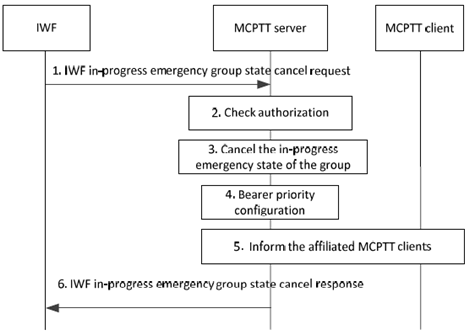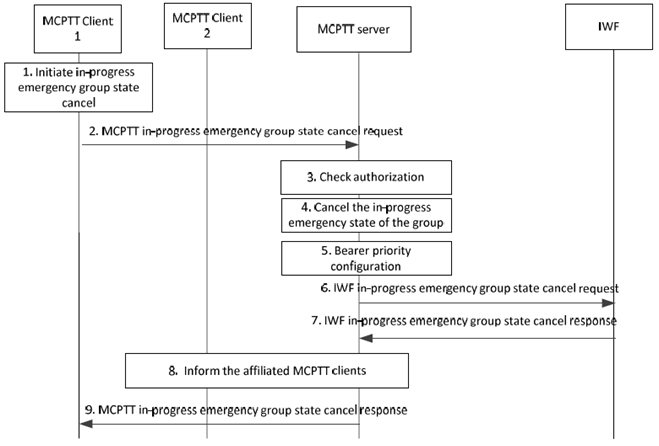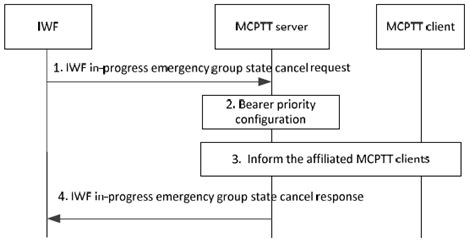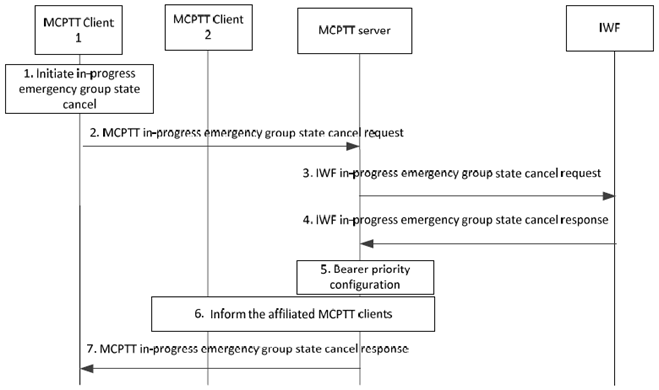Content for TS 23.283 Word version: 18.1.0
1…
10…
10.2…
10.2.2…
10.2.3…
10.3…
10.3.3…
10.3.3.7…
10.3.4…
10.3.4.4…
10.3.5…
10.3.5.8…
10.3.6…
10.3.7…
10.3.7.5…
10.3.8…
10.4…
10.4.4…
10.5…
10.5.7…
10.6…
10.6.2…
10.6.2.3…
10.6.3…
10.6.4…
10.7…
10.8…
10.11…
10.11.4…
10.12…
10.14…
10.15…
10.6.2.3 In-progress emergency group state cancel of an interworking group
10.6.2.3.1 LMR user initiated in-progress emergency group state cancel of an interworking group defined in the MCPTT system
10.6.2.3.2 MCPTT user initiated in-progress emergency group state cancel of an interworking group defined in the MCPTT system
10.6.2.3.3 LMR user initiated in-progress emergency group state cancel of an interworking group defined in an LMR system
10.6.2.3.4 MCPTT user initiated in-progress emergency group state cancel of an interworking group defined in an LMR system
10.6.2.4 Losing audio
10.6.2.5 Default emergency group
10.6.2.6 Emergency private call
10.6.2.7 LMR systems that do not track group emergencies
...
...
10.6.2.3 In-progress emergency group state cancel of an interworking group p. 127
10.6.2.3.1 LMR user initiated in-progress emergency group state cancel of an interworking group defined in the MCPTT system p. 127
Figure 10.6.2.3.1-1 shows the procedure for an in-progress emergency group state cancel initiated by an LMR user. The Figure is based upon the Figure for MCPTT in-progress emergency group state cancel in subclause 10.6.2.6.1.3 of TS 23.379.
Pre-conditions:
- The MCPTT group is in an in-progress emergency group state.
- The MCPTT group is an interworking group defined in the MCPTT system.
- The MCPTT client is affiliated to the MCPTT group.
- The IWF is connected to and is authorized to interwork with the MCPTT system.
- The mapping relationship of group and user identities between the MCPTT system and the LMR system has been configured at the IWF.
- An LMR user initiates in-progress emergency group state cancel of an interworking group.

Figure 10.6.2.3.1-1: LMR user initiated in-progress emergency group state cancel of an interworking group defined in the MCPTT system
(⇒ copy of original 3GPP image)
(⇒ copy of original 3GPP image)
Step 1.
The IWF sends an IWF in-progress emergency group state cancel request to the MCPTT server. The IWF in-progress emergency group state cancel request may carry an indication that the emergency alert of the user is also being cancelled.
Step 2.
The MCPTT server checks that the initiator of the request is authorized to cancel the in-progress emergency group state of the group.
Step 3.
The MCPTT server cancels the in-progress emergency group state of the MCPTT group. If the emergency alert of the user is also requested to be cancelled, the MCPTT server cancels the emergency alert of the user.
Step 4.
The MCPTT server adjusts the priority of the underlying bearer; priority treatment is no longer required.
Step 5.
The MCPTT server handles the MCPTT in-progress emergency group state cancel request towards the affiliated MCPTT clients as defined in subclause 10.6.2.6.1.3 of TS 23.379.
Step 6.
The MCPTT server sends an IWF in-progress emergency group state cancel response to the IWF to confirm the IWF in-progress emergency group state cancel request.
10.6.2.3.2 MCPTT user initiated in-progress emergency group state cancel of an interworking group defined in the MCPTT system p. 128
Figure 10.6.2.3.2-1 shows the procedure for an in-progress emergency group state cancel initiated by an MCPTT user. The Figure is based upon the Figure for MCPTT in-progress emergency group state cancel in subclause 10.6.2.6.1.3 of TS 23.379.
Pre-conditions:
- MCPTT group is in an in-progress emergency group state.
- The MCPTT group is an interworking group defined in the MCPTT system.
- MCPTT client 2 is affiliated to that MCPTT group.
- The IWF is connected to and is authorized to interwork with the MCPTT system.
- The mapping relationship of group and user identities between the MCPTT system and the LMR system has been configured at the IWF.

Figure 10.6.2.3.2-1: MCPTT user initiated in-progress emergency group state cancel of an interworking group defined in MCPTT system
(⇒ copy of original 3GPP image)
(⇒ copy of original 3GPP image)
Step 1.
The MC user of MCPTT client 1 initiates in-progress emergency group state cancel of an interworking group.
Step 2.
The MCPTT client sends an MCPTT in-progress emergency group state cancel request to the MCPTT server. The request may carry an indication that the emergency alert of the user is also being cancelled.
Step 3.
The MCPTT server checks that the initiator of the request is authorised to cancel the in-progress emergency group state of the group.
Step 4.
The MCPTT server cancels the in-progress emergency group state of the MCPTT group. If the emergency alert of the user is also requested to be cancelled, the MCPTT server cancels the emergency alert of the user.
Step 5.
The MCPTT server adjusts the priority of the underlying bearer; priority treatment is no longer required.
Step 6.
The MCPTT server sends the IWF in-progress emergency group state cancel request to the IWF.
Step 7.
The IWF sends the IWF in-progress emergency group state cancel response to the MCPTT server to confirm the IWF in-progress emergency group state cancel request.
Step 8.
The MCPTT server handles the MCPTT in-progress emergency group state cancel request towards the affiliated MCPTT clients as defined in subclause 10.6.2.6.1.3 of TS 23.379.
Step 9.
The MCPTT server sends the MCPTT in-progress emergency group state cancel response to the MCPTT client 1 to confirm the MCPTT in-progress emergency group state cancel request.
10.6.2.3.3 LMR user initiated in-progress emergency group state cancel of an interworking group defined in an LMR system p. 129
Figure 10.6.2.3.3-1 shows the procedure for an in-progress emergency group state cancel initiated by an LMR user.
Pre-conditions:
- MCPTT group is in an in-progress emergency group state.
- The MCPTT group is an interworking group defined in the LMR system.
- The MCPTT client is affiliated to the MCPTT group.
- The IWF is connected to and is authorized to interwork with the MCPTT system.
- The mapping relationship of group and user identities between the MCPTT system and the LMR system has been configured at the IWF.
- An LMR user initiates in-progress emergency group state cancel of an interworking group.

Figure 10.6.2.3.3-1: LMR user initiated in-progress emergency group state cancel of an interworking group defined in the LMR system
(⇒ copy of original 3GPP image)
(⇒ copy of original 3GPP image)
Step 1.
The IWF sends an IWF in-progress emergency group state cancel request to the MCPTT server.
Step 2.
The MCPTT server adjusts the priority of the underlying bearer; priority treatment is no longer required.
Step 3.
The MCPTT server handles the MCPTT in-progress emergency group state cancel request towards the affiliated MCPTT clients as defined in subclause 10.6.2.6.1.3 of TS 23.379.
Step 4.
The MCPTT server sends an IWF in-progress emergency group state cancel response to the IWF to confirm the IWF in-progress emergency group state cancel request.
10.6.2.3.4 MCPTT user initiated in-progress emergency group state cancel of an interworking group defined in an LMR system p. 130
Figure 10.6.2.3.4-1 shows the procedure for an in-progress emergency group state cancel initiated by an MCPTT user. The Figure is based upon the Figure for MCPTT in-progress emergency group state cancel in subclause 10.6.2.6.1.3 of TS 23.379.
Pre-conditions:
- MCPTT group is in an in-progress emergency group state.
- The MCPTT group is an interworking group defined in the LMR system.
- MCPTT client 2 is affiliated to that MCPTT group.
- The IWF is connected to and is authorized to interwork with the MCPTT system.
- The mapping relationship of group and user identities between the MCPTT system and the LMR system has been configured at the IWF.

Figure 10.6.2.3.4-1: MCPTT user initiated in-progress emergency group state cancel of an interworking group defined in the LMR system
(⇒ copy of original 3GPP image)
(⇒ copy of original 3GPP image)
Step 1.
The MC user of MCPTT client 1 initiates in-progress emergency group state cancel of an interworking group.
Step 2.
An MCPTT client sends an MCPTT in-progress emergency group state cancel request to the MCPTT server. The request may carry an indication that the emergency alert of the user is also being cancelled.
Step 3.
The MCPTT server sends the IWF in-progress emergency group state cancel request to the IWF.
Step 4.
The IWF sends the IWF in-progress emergency group state cancel response to the MCPTT server to confirm the IWF in-progress emergency group state cancel request.
Step 5.
The MCPTT server adjusts the priority of the underlying bearer; priority treatment is no longer required.
Step 6.
The MCPTT server handles the MCPTT in-progress emergency group state cancel request towards the affiliated MCPTT clients as defined in subclause 10.6.2.6.1.3 of TS 23.379.
Step 7.
The MCPTT server sends the MCPTT in-progress emergency group state cancel response to the MCPTT client 1 to confirm the MCPTT in-progress emergency group state cancel request.
10.6.2.4 Losing audio p. 132
For LMR systems where a user cannot be pre-empted, the IWF identifies the audio as losing audio to the system. Subclause 10.5 is applicable to losing audio during emergency calls as well as non-emergency calls.
10.6.2.5 Default emergency group p. 132
In MCPTT, the user's profile determines whether an emergency is raised on the user's currently selected group or on a configured default emergency group. It's up to the IWF and the LMR system to which it is connected to determine what group the emergency is raised on and whether an alert is also sent when the emergency is raised. From the perspective of the MCPTT system, all emergency behavior by the IWF on behalf of its users mapped to MCPTT shall comply with behaviors defined in TS 23.379. The implementation shall ensure that emergency related parameters of a group or private call are adhered to. For example, an MC service group must be configured in the MC sevice group managment system for emergency alerts in order for an emergency alert to be sent on it. This can be enforced through proper configuration of both LMR and MCPTT systems or can be enforced at run time by the IWF.
10.6.2.6 Emergency private call p. 132
An emergency private call to an LMR user will have emergency priority for the portion of the call transported in the MCPTT system and the LTE EPS but will not receive priority on the LMR system in LMR systems that do not support emergency treatment for private calls.
10.6.2.7 LMR systems that do not track group emergencies p. 132
The MCPTT system tracks the emergency state of every group. In interworked LMR systems that do not track the emergency state of groups, only a UE in emergency state will be given emergency priority on the LMR system when talking. For any user talking on an emergency group, the portion of the call transported by the MCPTT system will receive emergency priority.